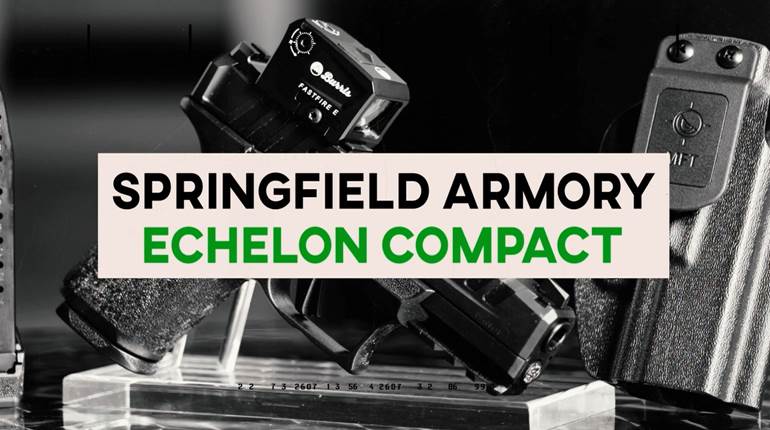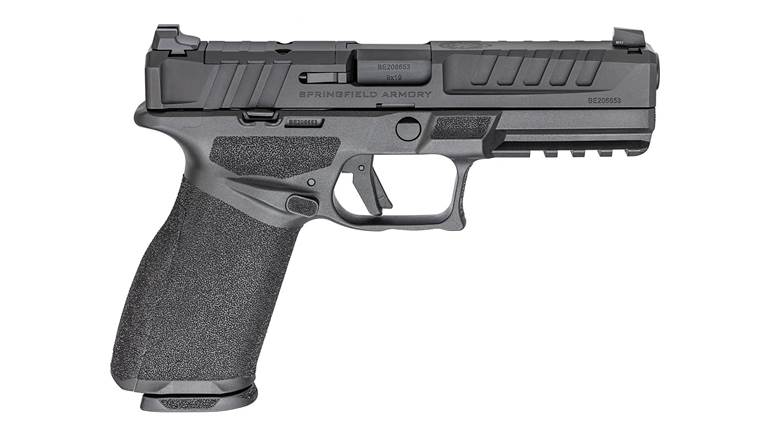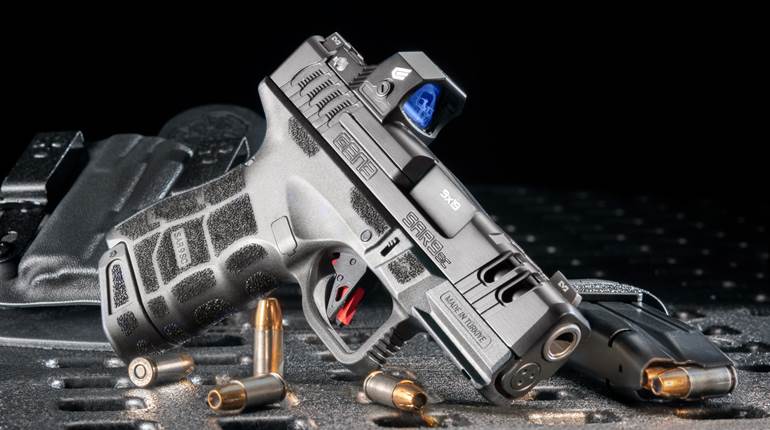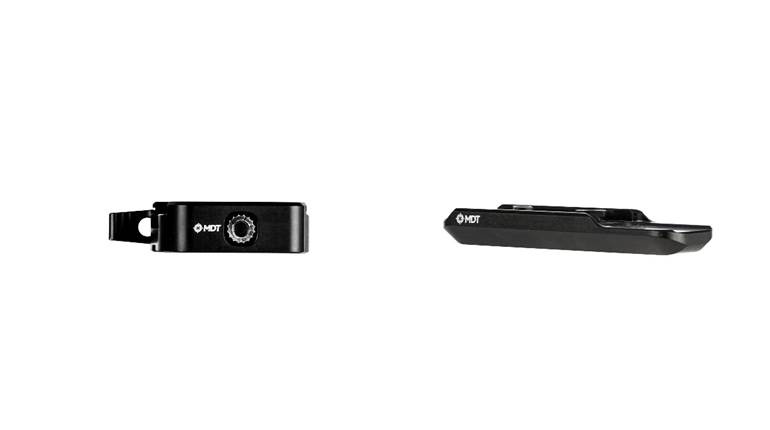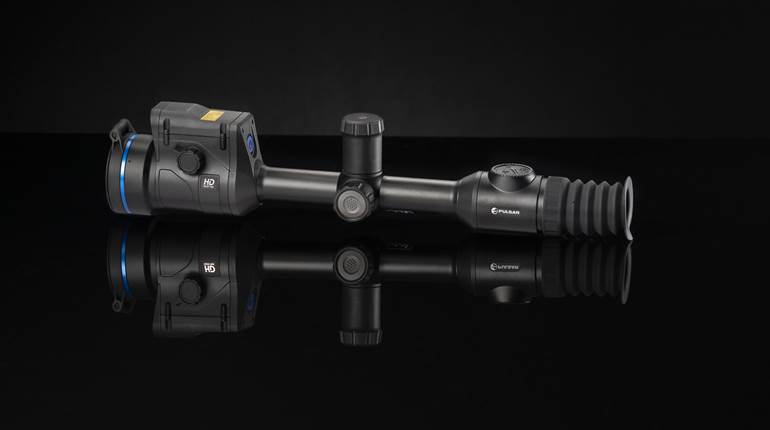
Back in the early 2000s, tech companies raced each other to the top in seeing who could create the smallest cellphone. You had phones that slid open, flipped open, had tiny mechanical keyboards and stamp-size screens, all while boasting the latest features packed into an ever-shrinking package. Then, consumer priorities changed, and now, companies are creating seemingly ever-bigger smartphones, many of which struggle to fit into the front pocket of your average jeans.
In some ways, the firearm market is undergoing the same evolutionary change in terms of compact, concealed-carry guns. For the past few years, many major firearm makers have been competing to see who can get as many rounds as possible into an ever-shrinking package. While that’s paid dividends to shooters in the way of highly capable defensive platforms that are easy to carry every day, such efforts belie the fact that, for literally decades before the advent of the micro-compact, many armed citizens carried larger self-defense guns quite comfortably on a regular basis. For those folks who don’t mind having a little extra to conceal in the way of weight and dimensions, Springfield Armory’s new Hellcat Pro incorporates the best innovations of the micro-compact concept into a package that, while still easily concealable, is larger than the new guns we’ve seen in the last few years.
Right now, some are asking the question, “Why would I want a bigger gun that’s harder to conceal?” and that’s a valid query, particularly for those millions who’ve entered into gun ownership during the height of the micro-compact craze. Small guns such as Springfield Armory’s original Hellcat are some of the best sellers on the market, and that’s because people are more likely to carry them. The problem is that micro-compacts are not some kind of cure-all miracle CCW tools. With every give, there’s a take, and among all of the waxing lyrical on the wonderful benefits of the micro-compact (of which I am as guilty as anyone), nobody can escape some very real shortcomings. The Hellcat Pro helps to address some of those issues in a package that’s not all that much different from the original Hellcat, while bringing in some nice bonuses.

Springfield bills the Pro as being “the perfect balance,” and, at first blush, that doesn’t seem to be pure marketing mumbo. So as not to bury the lede any further, the Hellcat Pro offers a longer frame, slide and barrel and a greater capacity relative to the original Hellcat. It’s sort of a “mid-size” micro-compact, the mid-size being relative to the traditional double-stack handguns we’re used to, such as Springfield’s XD-M line. Otherwise, both the Hellcat and the Hellcat Pro are highly similar in many ways.
They’re both short-recoil, striker-fired handguns employing the ejection-port locking system popularized by SIG on the P220 and seen in earlier designs like the P210 and the M1935S. Combined with this locking system is a Glock-style striker mechanism, which is partially loaded when the firearm is cocked but is not fully pre-tensioned. Pulling the trigger actuates a connector that fully loads the striker spring while clearing several internal safeties, a simple, elegant system found on many of today’s firearms. The Pro, like the Hellcat and many of Springfield’s other handguns, is made by HS Produkt in Croatia.
Looking at the two Hellcats side-by-side, the familial lineage is clear. The slides are outfitted with cocking serrations front and rear, with both having six wide grooves and five small grooves at the rear and the Pro having another wide and small groove at the front, due to its added length. At the muzzle end, the slides are beveled, with the Pro having a shallower taper to its full width than the original Hellcat. Dimensionally, aside from overall length, the slides and barrels seem to be functionally identical. Both are outfitted with Springfield’s fantastic “ball-in-basket” U-notch sighting system.

Length-wise, the Pro measures in at 6.6" compared to the Hellcat’s 6", and the subsequent change in sight radius measures in at 0.53", which is a substantial difference in a concealed-carry gun. For those unfamiliar, sight radius is the distance between the rear sight and the front sight on any gun. The longer the sight radius, the more precise a shooter can be, because the added length minimizes point-of-impact changes resulting from misalignment of the front sight relative to the rear sight. Of course, this is only an issue if you’re relying on iron sights, and many shooters aren’t these days, what with the advent of the micro red-dot (MRD), which provides an aiming dot projected onto a glass window and, thus, provides a single-plane sighting system that does not rely on sight radius.
Unsurprisingly, Springfield accommodates micro red-dot reflex sights on its Hellcat Pro, which comes with a slide milled to accept optics with the Shield-style mounting footprint, of which Springfield’s Hex Wasp is an example. In the interests of full disclosure, Springfield did send me a Hellcat Pro outfitted with the company’s Hex Wasp MRD, but, to date, the company does not offer it with a factory-installed red-dot. As a result, I elected to do the bulk of my shooting with the open sights only, as that’s the package consumers will receive. Given that, the increased sight radius was a real benefit, and for those who prefer to stay with irons on their go-to personal-defense gun, the Pro is the one to have on that front alone.
Worth mentioning, too, is the fact that the Pro is equipped with a 3.7" barrel relative to the Hellcat’s 3" barrel. Depending on the load, it’s possible to squeeze some extra velocity out of that additional 0.7", and while any increase there might seem marginal, more energy on target is nothing to sneeze at when you’re only getting around 300 ft.-lbs. of energy out of a 9 mm round anyway.
While the slides are similar in every respect except length, the frame is where there are some real differences. The Pro’s frame is 0.8" taller than the original, offering it a standard magazine capacity of 15 rounds, which means it accepts the extended magazine released initially as an aftermarket capacity upgrade for the original Hellcat. Because of the added height of the Pro’s grip frame, the shorter 11- and 13-round magazines for the standard Hellcat will not function in the Pro.
The taller grip itself does more than just allow for the magazine, though. I don’t have particularly large hands, and with a standard, flush-fit, 11-round magazine in the Hellcat, my pinky finger is left off the grip frame entirely. When equipped with an extended floorplate or the 13-round extended magazine, I get only a portion of my pinky on the grip, and, as anyone with any experience shooting small, compact concealed-carry guns knows, having that third finger on the grip makes all the difference in being able to shoot accurately and precisely, particularly when firing rapidly.
On the Hellcat Pro, the frontstrap accommodates all my fingers, and I find that the spacing of the shallow finger grooves fits them perfectly. Some shooters with larger hands and beefier fingers will likely find their little finger spilling off a bit, but it’s still a significant improvement over the micro-compact Hellcat in that regard. Texture-wise, both guns feature the “adaptive grip texture” touted by Springfield, with small pyramidal points wrapping the entire circumference of the grip frame, as well as appearing in panels on both sides of the frame just above the magazine release where the shooter’s dominant hand thumb should rest in a firing grip. There’s also a small, rectangular patch located on either side of the frame just forward of the takedown lever, which is a good touch-point for the support-hand thumb, and, for my hand, the opposite panel is perfectly placed to allow my trigger finger to rest outside of the trigger guard when I’m not ready to fire.
In terms of controls, the Pro replicates the single-sided controls found on the original Hellcat in most respects. There’s a fenced-in slide-stop lever located on the left side of the frame, and it features three deep channels that provide purchase when actuating it with a thumb. Also found on the left side from the factory is a push-button magazine release located just to the rear of the trigger. While single-sided only, it is reversible for left-handed shooters, and Springfield outlines the reversal procedure in the gun’s manual. Given that the slide-stop lever is not mirrored, the Pro is not the most lefty-friendly handgun we’ve seen recently, but its mirrored grip texture and ergonomics, combined with its reversible magazine release, at least makes it usable for lefties. Of note on that front is that while Springfield does offer a manual-safety version of its original Hellcat, complete with bilateral safety levers, there is no manual-safety-equipped version of the Pro to date.
From a casual glance, it might seem evident to some that all Springfield’s done on the Pro is to literally stretch the frame in terms of length and height, but a closer examination shows that there’s a lot more that’s different than similar on the frame, dimensionally speaking. A closer look of the Hellcat will show thicker proportions on the polymer trigger guard, with the front portion of the guard measuring 0.175" on the Pro and 0.128" on the standard Hellcat. The size difference fluctuates at varying points around the trigger guard, but there is certainly more material on the Pro. While the internal dimensions of the magazine well are the same on both guns, externally, there’s a shade more material within the grip frame itself, coming out at about 0.06" more.
Visually, you can see this in the contouring just behind the magazine release on both guns, as the original Hellcat has slight curves on the top and bottom of this section, while the Pro only has the blending on the top portion, where the grip shrinks just below the slide. Having been unaware of this slight difference early on, I thought the Pro grip just felt intangibly “better,” which, of course, is an entirely subjective consideration, but it was there, nonetheless. Putting a measuring tape on both grips, just below the trigger guard undercut, shows about an 1/8" difference in overall circumference, which is not insignificant. Springfield says that the purpose of these dimensional changes is to provide “even more strength and rigidity to that area” of the frame—likely because of the greater reciprocating mass of the longer slide. Of course, what this means in the real world is that holsters designed for the original Hellcat will not work for the Pro, and vice-versa.
With the technical examination behind us, let’s examine some of the practical elements of the Pro. I’ve been shooting the Hellcat Pro off and on for some time now and have clocked more than 600 rounds through it, including Winchester 90-grain Super Clean, Sellier & Bellot 115-grain FMJ and assorted mixes of defensive and FMJ loads of different weights without any malfunctions. It’s been boringly reliable, which makes it a great choice for self-defense. It’s longer, taller, wider and heavier than the original Hellcat, so it stands to reason that it might be milder-shooting. Like the original, though, the Pro is a dedicated carry gun, and like all CCW pistols, it takes some work to shoot well. Of course, the lengthened sight radius and greater gripping surface helps in getting on target and maintaining control, particularly during more rapid strings of fire, but a range toy it isn’t. This is important to note for Hellcat owners out there who may be looking to the Pro as a possible easy-to-shoot range trainer.
Another point to consider for range use is the magazines. Springfield’s 15-round magazines are a clear benefit in the capacity category, but they are not as easy to fill without the aid of a loader. In particular, I struggled to load the last two rounds by hand, particularly toward the end of a range session with tired, sweaty fingers. Accordingly, Springfield includes a magazine-loading tool as an accessory, and others, such as my go-to Maglula UpLULA, also make the task much easier. An extra magazine is a big benefit in getting more trigger time, too, and Springfield thoughtfully provides one with each Pro model.

One definite benefit to the Pro is its sights, which provide a wonderfully clear front dot on which to focus, and I found it naturally intuitive to settle the dot into the U-notch rear sight and put rounds on target quickly and easily. An additional benefit built into this sighting system is the tritium illumination, which is a must-have on a defensive firearm that might be employed in low light. As can be seen from the nearby shooting results, the accuracy of the Pro was more than acceptable for a defensive gun. Really, for this kind of platform, I’m less preoccupied with tenths of an inch on paper and more concerned with how quickly and easily I can get rounds on target. Shooting the Pro, I found that I could do so rapidly and intuitively, thanks to those sights, which are easily some of the best found on a factory pistol today.
I found the trigger to break consistently and predictably after a spongy, grit-free take-up. It’s not a competition trigger by any means, but it’s perfectly fine on a defensive gun. One note on the trigger that was unusual in my experience was that, during some extended range sessions stretching into the hundreds of rounds, I experienced some skin irritation developing on the edge of my index finger’s pad. I tend to place my index finger lower on the trigger shoe, and the only explanation I can come up with is that there’s a more pronounced angle on the bottom edge of the trigger shoe. Shorter range sessions produced no such irritation, and anyone else’s shooting experience may differ, depending on how they interact with the trigger.
In terms of carry, I holstered the Pro in BlackPoint Tactical’s new DualPoint 2.0 ($90) and carried the gun in my preferred AIWB position, though the holster also works for a strong-side draw. Naturally, the lengthened grip frame of the Pro requires a little extra effort to conceal compared to the original Hellcat, but anyone used to carrying a larger pistol, like the Glock 19, will not find it difficult. My go-to CCW pistol is generally a G19 Gen5, and the Pro is certainly easier to carry than the Glock. Considering that it shares the same chambering and, now, the same capacity, that makes it a much more attractive choice for daily carry. In terms of aftermarket support, the Hellcat Pro has a long way to go before it matches the likes of Glock or even Springfield’s XD line. That said, however, the company is making a concerted effort to ensure that you get what you need in the first place. Upgraded sights? Already on the gun. Holster support? You can find options from many of the major makers, including Galco, DeSantis and CrossBreed. Possibly the only ding on that front is that the Pro is limited to 15-round flush-fit magazines, but compared to every other micro-compact out there, you’re already ahead in terms of capacity.
As it stands, the Hellcat Pro has a bit of a hill to climb when it comes to supplanting the now-ubiquitous micro-compact. But what the micro-compact brought to the marketplace might spell its death knell someday. The ubiquity of the flip phone made it possible for people to have a technological tool that allowed them to access information anywhere, anytime, and the subsequent consumer desire for larger screens to take full advantage of on-demand Internet access killed the micro phone.
For the micro-compact, the improved stagger-stack magazine inside of it is an innovation that manufacturers have yet to fully capitalize upon. Will consumers demand larger magazines with more capacity in the future? Time will tell. What is true is that many armed citizens have carried and easily concealed larger guns than the Hellcat or even the Hellcat Pro for a long time. Is the Hellcat Pro our first glimpse at this next generation of mid-size CCW guns? We’ll see. For now, American shooters can carry the Hellcat Pro confidently, knowing that they’re on the cutting edge of capable, concealable, capacity-rich personal-defense guns.













